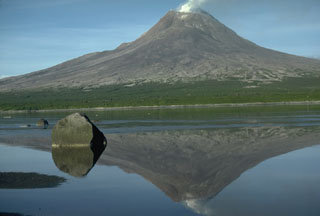Report on Augustine (United States) — September 1989
Scientific Event Alert Network Bulletin, vol. 14, no. 9 (September 1989)
Managing Editor: Lindsay McClelland.
Augustine (United States) Fumaroles cooler; deformation and magnetics little changed
Please cite this report as:
Global Volcanism Program, 1989. Report on Augustine (United States) (McClelland, L., ed.). Scientific Event Alert Network Bulletin, 14:9. Smithsonian Institution. https://doi.org/10.5479/si.GVP.SEAN198909-313010
Augustine
United States
59.3626°N, 153.435°W; summit elev. 1218 m
All times are local (unless otherwise noted)
Geologists returned to Augustine in July 1989 for additional monitoring of magnetic changes, deformation, and fumarolic activity. The following is from the Alaska Volcano Observatory.
Magnetic data (Dan Dzurisin). David Schneider and John Power remeasured a 25-point N-S magnetic profile across the 1986 lava dome. Little change had occurred since the previous measurement in June 1988, although similar measurements on the Mt. St. Helens dome indicated that its Curie Point isotherm migrated inward at a rate of 3 ± 1 cm/day from 1984 to 1986. Geologists suggested that the proximity of a relatively active magmatic system at Augustine may retard cooling of the 1986 dome, or that differing rock magnetic properties may account for apparent differences in cooling rates.
Deformation (Gene Iwatsubo and John Power). The deformation network established in June 1988 was reoccupied in early July 1989, and several additional EDM lines were added. Preliminary data showed no significant changes in the lengths of pre-existing lines, indicating that no deformation was occurring to the cone and summit dome complex.
Gas measurements (Robert Symonds and Robert Andres). July 1989 fieldwork indicated that fumarolic activity had decreased significantly since the previous gas measurements in August 1987. Maximum temperatures at a fumarole field on the 1986 lava dome had dropped to 640°C on 6 July 1989 from 870° on 28 August 1987. A condensate sample from the 640° fumarole had a magmatic isotopic signature (delta D = -36, delta 18O = +8.8) and a higher Cl/SO4 weight ratio of 19 (16,000 ppm Cl, 840 ppm SO4) compared to Cl/SO4 ratios of 8.7-9.6 from the same fumarole field in August 1987. Geologists noted that the lower temperatures and higher Cl/SO4 ratio (due mostly to a lower SO4 content) suggest that the magma supply has become more degassed since 1987. Estimated SO2 emission rates of 72 ± 14 metric tons/day (t/d) on 10 July 1989 were slightly higher than 1987 values (45 ± 7 t/d on 24 May, 27 ± 6 t/d on 24 August), but uncertainty in estimated wind speed made comparisons ambiguous.
Geological Summary. Augustine volcano, rising above Kamishak Bay in the southern Cook Inlet about 290 km SW of Anchorage, is the most active volcano of the eastern Aleutian arc. It consists of a complex of overlapping summit lava domes surrounded by an apron of volcaniclastic debris that descends to the sea on all sides. Few lava flows are exposed; the flanks consist mainly of debris-avalanche and pyroclastic-flow deposits formed by repeated collapse and regrowth of the summit. The latest episode of edifice collapse occurred during Augustine's large 1883 eruption; subsequent dome growth has restored the edifice to a height comparable to that prior to 1883. The oldest dated volcanic rocks on Augustine are more than 40,000 years old. At least 11 large debris avalanches have reached the sea during the past 1,800-2,000 years, and five major pumiceous tephras have been erupted during this interval. Recorded eruptions have typically consisted of explosive activity with emplacement of pumiceous pyroclastic-flow deposits followed by lava dome extrusion with associated block-and-ash flows.
Information Contacts: Daniel Dzurisin and Eugene Iwatsubo, USGS CVO; J. Power, Geophysical Institute, University of Alaska, Fairbanks; Robert Symonds and Robert Andres, Michigan Technological Univ.

